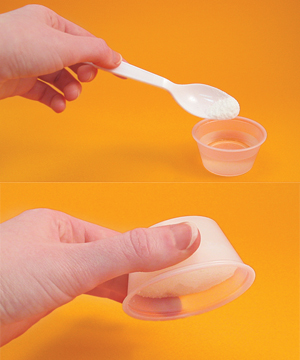 by: Tami O’Connor
by: Tami O’Connor
Though I am no longer in a traditional classroom, the end of each August still fills me with that feeling of eager anticipation and yes, even a bit of anxiety…. Then I remember, I’m not going to be facing a room filled with bright new faces nor will I need to develop the plethora of creative lesson ideas necessary to engage and stimulate young minds. But still, I enjoy sharing some of the school experiments that my students and I enjoyed.
One school activity I used to teach the scientific method required the use of an old favorite; Sodium Polyacrylate. This is the chemical powder found in disposable baby diapers. I would start my lesson with a 3 Cup Monty game in which I used 3 opaque cups that were identical in every way except that two of the cups were empty and in the third I placed about 3 tablespoons of the water lock powder.
My shtick started with me talking about the importance of observation skills. I would explain the necessity of having a keen eye. Shortly after my speech I would pour about 1/2 of a cup of water into one of the empty cups. While encouraging my students to carefully watch the cup with the water in it, I would move the cups around fairly slowly, knowing they would be able to follow the water filled cup easily, until the three cups ended in a line across my desk.
When the motion stopped, I would ask the class to identify the “water” cup. When they did, I would pour the water from the “water” cup to the other empty cup and repeat, only this time I would move the cups a bit more quickly. Since I am admittedly not very fast, most of my students were able to identify the “water” cup on the next try.
I continued two or three more times complimenting my students’ observation skills as they identified the correct “water” cup each try. On the last try, I would pour the water from the “water” cup into the cup with the powder hidden in the bottom. As you can imagine, the water was quickly absorbed by the sodium polyacrylate and solidified leaving no liquid behind in the cup.
On the final trial I moved the cups as quickly as I could trying to distract the students as much as possible as I shifted, bobbed, and weaved… I even stopped from time to time to point out the elusive leprechaun poking his head in the window, and while a few kids turned to look, I unfairly continued to move cups. Finally, when I sure I had fooled at least a few kids, I stopped.
With my three cups neatly lined across my desk, I would call on one student to identify the “water” cup. After pointing out the suspect cup, I flipped the chosen cup over to show there was no water in it. Try number two provided the students a 50-50 chance of identifying the “water” cup. Of course, one more wrong pick… Since I have already mentioned that I am fairly slow, chances were good that one of the chosen students had identified the correct “water” cup earlier, but because of the sodium polyacrylate, when I turned the cup upside down, the solid water remained stuck inside the cup.
There is always at least one student in the class who insists that the cup with the water in it has already been selected. I tend to call that student up to the front of the class to prove that their observation skills are the most astute by challenging them to stand under the last cup while I pour out whatever is inside it over their head. I build up the anticipation by having the guinea pig don a rain jacket…
While the class would cheer (and jeer) I would make quite a production of the cup over the brave (or foolish) student’s head being filled with water. As you already know, when I turned the final cup over, amid the oooooh’s and aaaaah’s, no water came out, and my student stayed dry. Imagine, three cups empty cups now, where at one point, at least one had water. There was no doubt, I had everyone’s attention
No matter what the grade level, this school experiment is sure to generate interest. Now, everyone knows that you can have a terrific introduction, but the lesson has to have teeth in order for our students to learn. There are a number of activities you can launch into immediately following this introduction.
- What is the ratio of water to powder that sodium polyacrylate will hold?
- What are the chemical differences between the water lock and snow polymer?
- Which baby diaper holds the most water?
- Why does adding salt to the solid water reverse the effect of the absorption?

Major thankies for the article post.Thanks Again.